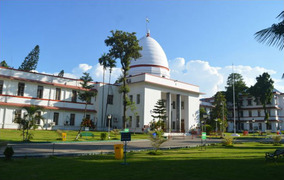By Sujit Bhar
In an interesting development that reminds one of many such disastrous happenings in the hills areas of India, the Gauhati High Court recently took suo motu cognisance of a newspaper report that talked about landslides during the current rains along the Bawngkawn and Durtlang (Leitan) road, near Leitan in Aizawl.
The landslide, as the newspaper report pointed out, was not a natural occurrence, but had happened because some construction work on the side of the road had chopped off major portions of supportive land. The division bench of the Court, comprising Justices Michael Zothankhuma and Marli Vankung, took suo motu cognisance of the report.
The land was being cut with no concern for the land and hills around it and the purpose was to develop a petrol pump. The problem, as the bench observed, was that earth was being removed from steep cliffs, but the construction was in no way connected to the Master Plan for Aizawl Vision 2030. That Master Plan has specifically discouraged the development on slopes of more than 36 degrees.
The reason for that was obvious: Such steep slopes, which remain loose without proper support, would tumble down as a landslide in the first rain. These landslides have not just disrupted traffic in the region, but have also affected the livelihoods of people within the Aizawl district and the state of Mizoram.
What the report found and the bench concurred with was that the road connecting Kawnpui to Aizawl from Sairang was in very bad condition. That forced drivers of small vehicles to take the alternative route from Bawngkawn to Durtlang towards Kawnpui. Heavy trucks, on 10 or more wheels, usually take the Aizawl-Khamrang-Kawnpui road, because it is less steep and wider.
This landslide has created a bottleneck in the busy road and local life has almost come to a standstill, with businesses suffering. Another alternative road that exists is longer and too winding, other than also being in a very poor condition.
The Court observed: “It is surprising to learn that the authorities, which are the state government and the Aizawl Municipal Corporation (AMC) have not taken any steps to discourage construction activity on the Bawngkawn-Aizawl road… As the state government and the AMC are not interested in taking serious note of the issue at hand, this Court has to step in, keeping in view the fact that public interest outweighs private interest.”
The Court also observed that houses are being randomly built on either side of the road, and the AMC seems to have granted such permission. The Court wondered how, with the slope on either side being as steep as 60 degrees, could the AMC allow such construction activities.
Adding to the Court’s cognisance was a letter from the convener of Indian National Trust for Art and Cultural Heritage (INTACH), Mizoram Chapter, which states that construction on the steep, ecologically fragile slope poses significant threat to the environment, human and wildlife habitats. INTACH points out that the location of the construction site is on a slope that is already prone to landslides and erosion. The ongoing activity is exacerbating the situation, causing irreparable harm to the ecosystem and putting the surrounding community at risk, says the letter.
The Court has now made the following parties in the case and notices have been issued.
- INTACH Mizoram Chapter.
- The State of Mizoram (respondent).
- The Secretary to the Government of Mizoram, Land Revenue & Settlement Department (respondent).
- The Secretary to the Government of Mizoram, UD&PA (respondent).
- The Secretary to the Government of Mizoram, Home Department (respondent).
- The Deputy Commissioner, Aizawl District, (respondent).
- The Superintendent of Police, Aizawl District, (respondent).
- The Aizawl Municipal Corporation (respondent).
Sadly enough, the Bawngkawn-Aizawl road leads to one of the most scenic views of Aizawl. Located within the complex of Aizawl Theological College (ATC) at Durtlang Hills, the View Point is the best place to see the city lights. Tourists are advised to go there at night, but the roads are treacherous now. The day sees the area covered in mist and a full view of the city is not available.
Travel guides say that the View Point at ATC is about 6-7 km from the city centre and one has use a bus to reach there. The plan for tourists is to take a bus and get down at Bawngkawn and transfer to another bus starting from there towards Durtland Road and get down at Durtlang Leitan.
Tourism is a major contributor to the state’s economy. Such mindless construction and the resultant disasters will drive tourists away, only harming the local people further.
Such activity and resultant environmental disasters are not new in India. This was seen at great cost in Joshimath and other places, which are now beyond repair. Even larger hill cities are too heavy today, resting on unsteady and loose soil.
Such activity not only disturbs the delicate balance of nature, but does irreparable harm to the environment. It is creditable that the Court has taken this up, and it is likely that it will set a commendable precedent for reckless authorities that go against all natural and other laws, just for more revenue.


